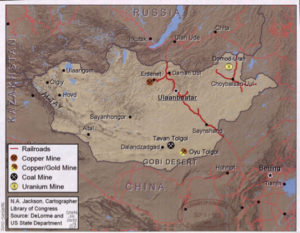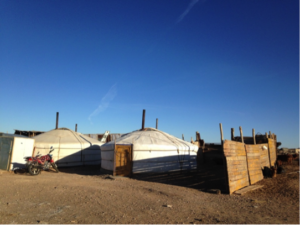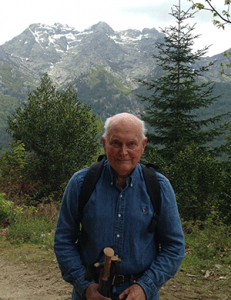by Peter Bridges
I had long been curious about Mongolia, a lightly populated country twice the size of Texas, which under Genghis Khan and his successors produced, in the 13th century CE, the largest contiguous land empire the world has ever known—9 million square miles. For much of the 20th century people spoke of Outer and Inner Mongolia. The Inner was firmly under Chinese control. The Outer claimed independence but was in fact the first Soviet satellite state, the Red Army having expelled Chinese troops in the early 1920s. The country was almost totally isolated from the rest of the world.
In 1939, Japanese forces advanced into Mongolia from China and were pushed back by Soviet forces, in battles that involved tens of thousands of troops but went almost totally unreported in the West. After World War II, Communist China sent twenty thousand or more “guest workers” into Mongolia. It was a prelude to colonization, as China had brought about in Inner Mongolia and would do later in Tibet and Xinjiang. The Soviets did not want a new Chinese state on their border. They and the Mongols managed to get the guest workers sent home.
What I knew about the past of Mongolia, Tibet, and Xinjiang came mainly from reading the work of three great explorers and travelers: Sven Hedin, Sir Aurel Stein, and the American diplomat William Woodville Rockhill, who once crossed Tibet on foot. (Henry Adams said that meeting with Rockhill was like having dinner with Genghis Khan.)
When I joined our embassy in Moscow in 1962, Mongolia was slowly asserting itself, taking advantage of the growing quarrel between its neighbors and sometime hegemons, Russia and China. Mongolia joined the United Nations in 1961, and other governments began to consider entering into diplomatic relations with it. The UK was the first major country to do so, in 1963, and the United States did so finally in 1987.

1963 Attempt to Visit Mongolia
One day in 1963 my counterpart in the Japanese embassy told me that Mongolia, the new UN member, was to host a United Nations seminar. Japan had no relations with Mongolia—but my friend had gotten Tokyo’s approval to attend the seminar in Ulaanbaatar as an “observer.” We sent a cable to Washington, proposing that I too go as an observer, as an add-on to a planned trip to Siberia. This would not amount to our diplomatic recognition of Mongolia. No, said the Department of State. You can debrief the Japanese diplomat when he gets back to Moscow.
A letter to me followed, from a friend in the Department. It’s the China lobby, he said. The only piece of China that the Chinese Nationalists control is Taiwan, but they claim the whole of the old empire—including Mongolia—and the Department does not want to irritate them. (This was a decade before Nixon’s break-through trip to Beijing.)
Very well, I thought, and soon took off for my planned trip to Siberia with my Australian colleague Bill Morrison. Western diplomats traveled all we could in the USSR, to learn what we could about that most secretive state. Sometimes we could visit a university or writers’ union or collective farm. Once I even visited a shoe factory, not quite as modern as the plants that produced jet fighters, but they never showed us those.
Morrison and I flew from Moscow to Khabarovsk, just a few miles from the Chinese border where later there were serious clashes. The authorities did not want Western diplomats poking around, and would do nothing for us. We then flew, as planned, to Irkutsk. Intourist had reserved us a room in the main city hotel but when we got there we were told bluntly that we had no reservations. Perhaps, said the clerk, we could stay in the transit hotel at the airport. We soon learned that Fidel Castro was due in town, and the city hotel had been turned over to his entourage.
We checked in at the transit hotel, two rows of rooms facing a large central space with tables and chairs. One chair was occupied by a man in a broad-brimmed hat and a long coat. The coat was certainly a deel, traditional Mongol dress—and the man was certainly a Mongol.
We greeted him in Russian, and he us. Bill explained that we were Western diplomats. He was quite willing to talk with us. He had been living in Moscow, and was returning to Ulaanbaatar via Irkutsk. (We had seen on the tarmac a twin-engine Li-2 with “Mongol Air” in English on its side.) The Soviet border police said there was some irregularity in his documents, and were holding him up for the moment.
We invited him to join us in our room for some Scotch whisky. Might we ask what his profession was? Philosophy, he said, 13th century Mongolian philosophy: “Genghis Khan!” He was, it seemed, more historian than philosopher. His specialty was The Secret History of the Mongols, a long and, I learned later, well-regarded work that begins with a blue-gray wolf and a fallow doe begetting the first Mongol, and goes on to recount more factually the campaigns of Genghis, and finally his death and ascent into heaven.
Mongolian Visitors to Houston in 1991
After the philosopher-historian I had no contact with Mongolians for a quarter-century.
In 1991 I had retired from the Foreign Service and was working for a major oil company in Houston. One day I was called by a friend at the Houston office of the Institute of International Education. Among IIE’s work was programming visitors to the US under the auspices of the State Department’s International Visitor Leadership Program. Each of our embassies is asked yearly to identify up-and-comers in Country X who have never been to America. As many as five thousand persons a year take part in this program, which pays for their travel to the US and around the country for several weeks. If they should want to see the Southwest, IIE Houston will arrange places to go and things to do—serious things, not vacationing. They go home with a better understanding of our country, and many or most go on to top jobs in their country. Many, like Margaret Thatcher in Britain, have become heads of government.
My IIE friend, who often called to ask whether I would like to see a particular visitor, said “Here’s something different. Two Mongolians are coming. I know your company’s not doing business in those parts, but would you like to see them?”
“Sure.”
The breakup of the USSR had given Mongolia new freedom to do its own thing. We had opened an embassy in Ulaanbaatar in 1988, and our ambassador was Joseph Lake, a career officer (and native Texan).
The Mongolians whom Lake’s embassy had nominated for travel grants were two department heads, one from the Economic Ministry, one from the Ministry of Foreign Affairs. Shall we speak Russian? I asked them. No need, thank you. Their English was good; one of them had just spent four years at their London embassy. I said I was happy to see them but we had no business interest in Mongolia. I went on to tell them about Houston and Texas, our politics and business and economics, our history and society.
1992 Mongolia Visit
Things changed. Next year I called on the two of them in Ulaanbaatar. Our company’s geophysicists had decided that after all the country’s petroleum deposits were worth exploring. The Mongolians were very pleased, and lodged our party of four in the large if not sumptuous mansion of Yumjaagiin Tsedenbal, who for decades had been the country’s pro-Soviet Communist leader. The mansion was located several miles from Ulaanbaatar, in a wooded valley between two low mountain ridges.
At dawn on the day after our arrival, our delegation head and I went for a run, down the valley road for a mile and then leftward, on a path we found that went upward through woods. We reached the grassy ridge—and saw a wolf looking at us, a hundred yards away. We admired one another, and then canis lupus sauntered down into the trees.
Later in the day we met with the president of the state oil company, and told him of our encounter with the wolf.
“Ah,” he said, “That is good luck. We shall surely sign a contract!”
That remained uncertain. The next day we spent on a tour by helicopter, a huge, slightly rusty Soviet-made Mi-24 that had seats for eight passengers and a crew of four, including an attractive cabin attendant who served us tea. We flew southeast from Ulaanbaatar to a land of grassy steppes and long views toward distant buttes.
We landed near a big round ger, and the people came to greet us. It was spring, the grass was good and green, and small herds of cattle and horses were grazing near and far. The scene reminded me of my days working on a drilling rig in Montana. Here there was no rig, at least for now, but there were a few shows of crude oil rising to the surface of the grassland.

I asked our Mongolian hosts if on the way back to Ulaanbaatar we could fly over the oilfield that the Russians had developed, not far from the railway that crosses Mongolia from Siberia to China. I knew only that production had ceased around twenty years earlier, after a refinery built along the railway had been destroyed in a fire.
We flew over the field at an altitude of several hundred feet. The Russians had simply walked away from the many derricks, leaving them to crumble over the coming decades if not centuries. From the field a wide black river of congealed oil stretched for miles across once pristine grassland. It was an appalling sight. We assured our hosts that our company would never be so irresponsible.
In the event, we did not sign a contract with the Mongolians. The political prospects for the country were favorable but the oil reservoirs looked too small to be profitable. Today Mongolia does produce oil, but in modest amounts. It is mining—copper, gold, coal, molybdenum—that has transformed the scene, producing a fast-growing economy and favorable balance of trade. Ulaanbaatar has sprouted sleek high-rises; but the suburbs are still groups of gers, and a third of the country’s population still live a pastoral life. I would not want to be a Mongolian nomad, but I am glad the traditional way of life continues.
A number of Mongolians, mostly educated people, have been emigrating to America. Here in Arlington, Virginia, they number several thousand, including five hundred students in our public schools, where Mongolian is the third most-spoken language after English and Spanish. Teachers call them exemplary students. A good addition, I think, to our national melting pot.
One can hope for still more contact between our two countries, in various fields. The State Department calls Mongolia a strategic partner, whose democracy is a model for the region. It is also a country with a serious corruption problem. We hope for more bilateral trade, but the country’s major trade partners remain China and Russia. The country is fiercely independent, but it must necessarily maintain a decent relationship with its two big neighbors. For now the scene is peaceful.![]()

Peter Bridges spent three decades as a Foreign Service officer on four continents, ending as ambassador to Somalia. In recent years he has published a memoir of his time as a diplomat; biographies of two once-famous Americans, John Moncure Daniel and Donn Piatt; and a memoir of his off-hours climbs, runs, and treks. His articles, essays, and poems have appeared in American Diplomacy, Copperfield Review, Diplomacy & Statecraft, Eclectica, Mountain Gazette, Virginia Quarterly Review, and elsewhere.
